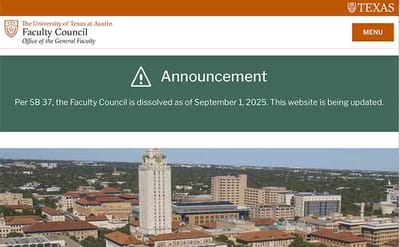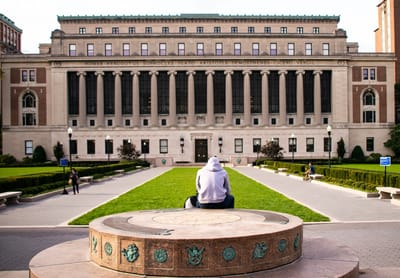Weekly War Bulletin: March 16

Federal Cuts & the Beginning of the Administration
In the few short weeks since the inauguration, higher education in the United States has faced government actions that represent severe threats to academic freedom, institutional autonomy, and financial stability.
This began with the announcement of the planned reduction in administrative offsets for NIH grants to 15% and an effective stoppage on processing new grants and renewing many preexisting ones. I was attending meetings at the Big10 Center in Chicago during the second wave of these actions and it was a dizzying experience to be conducting business as usual even as many in the room were facing catastrophe. Since then, I have come to understand that this cognitive dissonance will be something we will be navigating for the foreseeable future. Continuing our service, teaching, and research as we can even as the fires rage all around us.
The federal government is the largest single source of research funding for U.S. universities. Universities receive over $50 billion in federal research funding, accounting for 50–60% of total research expenditures as institutions such as ours. This number is significantly higher at some elite private institutions such as Johns Hopkins, where the number is 80% or more. JHU was the largest partner in USAID programs, and with the shuttering of those programs by the new administration they have faced an $800 million reduction in federal funding, leading to staff layoffs and project closures. In addition to the blow to the university and to the global initiatives USAID has supported, this will have a significant impact on the local economy as well.
If the 15% ultimately holds—and there seems to be optimism that the final number might be closer to 30%—the entire funding structure of our university would change dramatically, resulting in severe cuts across the university. In the absence of federal support, we can guess that these cuts will most directly impact areas with little opportunity to grow revenue in the form of enrollment or research dollars. Those in the Humanities should not imagine that these devastations will not impact them. They most certainly will.
Cut to Diversity & Equity Programs & the Demonization of “DEI”
While the extent of the announced cuts to federal research support for higher education was a shock to university officials, few were surprised by the ramping up of the attacks on Diversity, Equity, and Inclusion programs at universities. After all, the scapegoating of DEI had been an ongoing project of the administration’s supporters for some time and featured heavily in the presidential campaign.
During his joint address to Congress on March 4, Trump declared, “we’ve ended the tyranny of so-called Diversity, Equity and Inclusion policies all across the entire federal government and indeed the private sector and our military. And our country will be woke no longer.” The nature of this “tyranny” has never been spelled out, save with gestures towards a concept of “merit” DEI critics insist has been sacrificed to DEI. Of course, any such claims are made ridiculous by the raft of unqualified men and women nominated (and confirmed) to cabinet positions, including Secretary of Defense and Director of the FBI. Included in this roster is of course Linda McMahon, former WWE empresario, as the head of the Department of Education, which presumably will be shuttered as soon as it finishes its work of crushing the universities it was meant to serve.
The rush on the part of many major corporations to jump on board the new anti-DEI train was dizzying, with major social media companies leading the charge. For those of us in public higher education working in “red states,” even had the federal election gone differently, the end of our traditional DEI programs was already clearly in sight. In Ohio SB1 (formerly SB83) has the dismantling of all DEI programs at public universities as one of its key pillars. The February 14 “Dear Colleague” letter from the Office of Civil Rights in the Department of Education set a February 28 deadline for the dismantling of DEI programs based on a wildly broad interpretation of the Supreme Court’s decision ending affirmative action in college admissions. The legal status of that interpretation remains unclear, at best, and some blue states have brought suit challenging the notion that that narrow decision could extend to all programs. However, in Ohio, with an attorney general with political ambitions who is also the university’s chief legal authority, opportunities to challenge or “resist” the one-two punch of federal and state-level attacks on DEI programs remain non-existent at an institutional level.
On February 27, on the eve of the deadline spelled out in the “Dear Colleague” letter, Ohio State’s President Ted Carter announced the shuttering of our two major university initiatives in this space: the Office of Diversity and Inclusion and the Center for Belonging and Social Change.
Federal Attacks on Institutional Autonomy and Academic Freedom
On March 7, the administration announced it was revoking $400 million in federal grants to Columbia University, citing concerns over alleged antisemitic activities on campus. An additional 2 billion in grants are also being “reviewed.” On March 13, the administration sent a letter spelling out “preconditions” for “formal negotiations regarding Columbia University's continued financial relationship with the United States government.” These demands included that the university abolish its University Judicial Board, “reform” admissions processes, and place certain departments under “academic receivership” for no fewer than five years— conditions of said receivership to be set, presumably, by the administration.
It goes without saying that this is a major escalation in the assault on higher education and academic freedom, wrapped in the guise of concern around antisemitism and Civil Rights that clearly serves as little more than a pretext to flex power of the Ivy League institution. It will be interesting to see how Columbia responds in the weeks to come.
While thus far much of the animus has been directed against private institutions—and particularly Columbia—on Friday, Ohio State learned it was now on two lists of schools to be investigated by the new administration. The first list, shared on March 10, is made up of 60 institutions being investigated for antisemitism by the Office of Civil Rights. For us at OSU, it was not a surprise given that the University had already been under investigation since April 2024, when a complaint was filed with the Biden administration. What has changed, of course, is that the charge to the Department of Education to clear its backlog will likely result in many more unilateral decisions of the kind seen at Columbia. Up to $700 million in university federal funding is held hostage to this process.
The second list was announced March 14, citing 45 institutions being investigated for discrimination in PhD admissions. The pretext here is ostensibly the university’s participation with the PhD Project, a nonprofit working to improve access for underrepresented groups to get degrees in business. But at this point, it is naive to imagine that any of this is other than pretext. As with the supposed investment in “antisemitism” the concern here for Asian American students supposedly discriminated against is justification for the federal government to impose its will on higher education and to sow fear and anxiety.
ICE, the Alien & Sedition Acts, and Deportations
In January 2025, the Department of Homeland Security (DHS) rescinded guidance that previously limited immigration enforcement actions at “sensitive locations,” including schools and universities. This policy change permits Immigration and Customs Enforcement (ICE) to conduct arrests on college campuses, increasing the vulnerability of undocumented students and any instructor seeking to protect their students from arrest.
On Sunday March 9, Mahmoud Khalil, a recent Columbia graduate and one of the organizers of the April protests on the campus, was seized and brought to a prison in Louisiana for deportation. Khalil’s lawyer had informed the ICE agents that he possessed a green card, granting him legal status to live in the country. Even as the courts have held up the deportation, the president has made it clear that this is just the beginning and that many more students will be targeted. “We know there are more students at Columbia and other Universities across the Country who have engaged in pro-terrorist, anti-Semitic, anti-American activity,” he posted. “We will find, apprehend, and deport these terrorist sympathizers from our country — never to return again.”
It needs to be underscored that Khalil was charged with no crime for his participation in the protests in April. The deportation order was a decision made by the administration without charges, without due process, and with the administration serving as judge, jury, and executioner.
And even as the most urgent threat is faced by international students, it is clear from the above comments that the administration is willing to consider using these powers against domestic students involved in what being termed “illegal protests”—a non-legal category which the administration has not defined.[1] The March 10 post celebrating the arrest of Khalil as “the first arrest of many to come” does not specify international students as the object of pursuit but instead threatens students “across the Country who have engaged in pro-terrorist, anti-Semitic, anti-American activity.” Another post a week earlier makes this point clearer:
All Federal Funding will STOP for any College, School, or University that allows illegal protests. Agitators will be imprisoned/or permanently sent back to the country from which they came. American students will be permanently expelled or, depending on on [sic] the crime, arrested.
Finally, late last week the administration invoked the Alien Enemies Act, the last remaining of the Alien & Sedition laws of 1798, as justification for mass deportation of those the administration determines to be at war with the U.S. because of ostensible involvement with a Venezuelan gang. This law was last used during WWII to authorize the forcible internment in concentration camps of Japanese and Japanese Americans. Despite a court order demanding that the deportation of cease immediately, the deportation flights continued, with threats mounting against the federal judge who is standing in the administration’s way.
There is good reason to believe this administration is testing both the limits of court authority and the public appetite for using unconstitutional powers against declared “enemies” more broadly. The refusal to abide by court blocks on executive orders and actions points to the larger challenge of the moment: with no legislative checks on the increasingly concentrated power of this administration, it is the courts alone which can provide any brake on unconstitutional actions.
The administration is keenly aware of this, and it finds a role model in Andrew Jackson—whose portrait President Trump restored to the oval office in January. As Jackson infamously (and likely apocryphally) declared when the Supreme Court decided in favor of tribes fighting removal, “John Marshall has made his decision, now let him enforce it.” The Trail of Tears that followed, despite the Court’s decision—and the deaths of many thousands of members of the Cherokee, Seminole, and Creek nations—tragically proved Jackson’s point.
Planned Abolition of the Department of Education
The impact of the closure of the Department of Education will be especially intense for public universities. The Department manages federal grants, research funding, and student aid. Its dissolution will likely result in Pell Grants for low-income students being turned over to the states, which will be under no federal guidance in terms of how these grants are managed. It will eliminate the primary oversight of Title IX enforcement funding, impacting gender equity and campus safety policies. The Federal Student Loan program, currently managed by the department, will likely be turned over to the states or fully privatized. In either case we can expect to see increased interest rates and repayment costs, and the elimination of loan forgiveness programs and income-driven repayment plans.
I also greatly fear increased state impositions on public higher education curriculum and policy, something that has been actively sought out by state legislatures in Ohio and other Red States for some time now. And they have made considerable progress even without the closure of the Education Department, first with the imposition of conservative thought centers at state institutions (including here at OSU) and now with SB1’s plan to legislate a required civics course. As we know, states currently exercise control over K-12 curriculum in public schools. Without the Education Department, the likelihood is high that states will seek to exercise greater control over higher education policy, curriculum, and hiring practices.
One final major concern: without federal oversight of for-profit colleges, we can expect more bad actors to emerge in an already deeply troubled space. As we approach a significant demographic cliff, an incursion of unscrupulous for-profit institutions in the online space will disadvantage public and private institutions alike—especially as heavy cuts to federal funding put increased upwards pressure on tuition.
Endowment Taxes and a “National University”?
Since early in the 2024 campaign, Trump has discussed the idea of a national university—a “American Academy”—which will be free to all and funded by taxing the endowments of elite private institutions. It is unclear how seriously the President is about this plan, but it is something that all in education should be watching closely.
In December, then-Senator J.D. Vance introduced a bill which would raise the tax on endowments for private educational institutions whose assets exceeded $10 billion. Currently such endowments are taxed at 1.4%, and Vance’s proposal was to raise that rate to 35%. Since then, at least two competing bills have been introduced which seek to dramatically increase taxes on endowments of wealthy universities.
The odds of a major endowment tax increase are high, which will be devastating to the research universities currently facing existential threats from federal funding freezes and cuts. As a public institution, Ohio State would not be impacted by such a tax, but we most certainly would be impacted—along with the rest of higher education—by a new “free” national online university whose curriculum is controlled by the administration and whose tuition is covered by endowment taxes.
[1] Legally protest is protected by the first amendment, even as a protestor can be charged with illegal activity—including failure to obey lawful order—while engaged in an otherwise protected first amendment activity
Subscribe (always free)
Subscribe (free!) to receive the latest updates






Member discussion